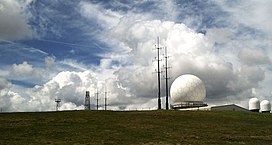Great Dun Fell
| Great Dun Fell | |
|---|---|
 The radar station on the summit | |
| Highest point | |
| Parent peak | Cross Fell |
| Listing | Hewitt, Nuttall |
| Coordinates | 54°40′59″N 2°27′05″W / 54.6831°N 2.4513°W |
| Geography | |
| Country | United Kingdom |
| County | Cumbria |
| Parent range | North Pennines |
| OS grid | NY710321 |
| Topo map | OS Landranger 91 |
At a height of 848 metres (2,782 ft), Great Dun Fell is the second-highest mountain in England's Pennines, lying two miles (three kilometres) south along the watershed from Cross Fell, its higher neighbour. Together with its smaller twin, Little Dun Fell, which reaches 842 m (2,762 ft),[1] it forms a stepping-stone for the Pennine Way on its long climb up from Dufton. It lies within the historic county boundaries of Westmorland, the ceremonial county of Cumbria, and the modern unitary authority area of Westmorland & Furness.
Radar station
At the summit there is a radar station which is operated by National Air Traffic Services and is a key part of the Air Traffic Control system for Northern England and Southern Scotland. A radome containing Primary Surveillance radar (PSR) and Secondary Surveillance Radar (SSR) antennas, various towers and fencing crown the summit. Alfred Wainwright abhorred the old radio station (removed in the 1980s) in his book Pennine Way Companion.[citation needed]
The construction of the radar station led to the repaving of a tarred road to the summit, which became Britain's highest road. This road is marked as private from just above the village of Knock, and is not open to public motor vehicles. However, it is a bridleway until shortly before the radar station, so it is open to walkers, cyclists and horseriders.[2]
Field station
The University of Manchester formerly had a permanent meteorological observatory at the Great Dun Fell site. It has hosted a number of field experiments doing research into clouds and their interactions with pollution. As the summit is in cloud for two thirds of the year it is an ideal location for this type of research. The university still has the option to use the site for short-term measurement periods.[3]
Hushing
There are the remains of hushing gulleys on the slopes of the mountain, created during lead mining of the Industrial Revolution.
Climate
Under the Köppen climate classification, Great Dun Fell has a subpolar oceanic climate (Cfc), closely bordering both a subarctic climate (Dfc) under the 0 °C (32 °F) isotherm and an alpine tundra climate (ET) due to a July mean of exactly 10 °C (50 °F). The Met Office station publishes only temperature and frost averages. The summers are cool due to elevation. Considering its elevation and a latitude of over 54 degrees, winters are relatively mild due to oceanic influences.[4]
| Climate data for Great Dun Fell 847 m (2,779 ft), 1991-2020 averages, 2000–present records.[a] | |||||||||||||
|---|---|---|---|---|---|---|---|---|---|---|---|---|---|
| Month | Jan | Feb | Mar | Apr | May | Jun | Jul | Aug | Sep | Oct | Nov | Dec | Year |
| Record high °C (°F) | 15.3 (59.5) |
12.1 (53.8) |
14.7 (58.5) |
18.0 (64.4) |
22.0 (71.6) |
21.6 (70.9) |
27.2 (81.0) |
29.7 (85.5) |
21.0 (69.8) |
18.7 (65.7) |
17.2 (63.0) |
14.3 (57.7) |
29.7 (85.5) |
| Mean maximum °C (°F) | 7.5 (45.5) |
7.9 (46.2) |
9.9 (49.8) |
12.6 (54.7) |
15.7 (60.3) |
18.1 (64.6) |
20.0 (68.0) |
17.6 (63.7) |
15.8 (60.4) |
12.5 (54.5) |
10.2 (50.4) |
8.1 (46.6) |
22.0 (71.6) |
| Mean daily maximum °C (°F) | 1.6 (34.9) |
1.6 (34.9) |
2.8 (37.0) |
5.4 (41.7) |
8.6 (47.5) |
11.0 (51.8) |
12.5 (54.5) |
12.3 (54.1) |
10.1 (50.2) |
6.8 (44.2) |
4.0 (39.2) |
2.1 (35.8) |
6.6 (43.8) |
| Daily mean °C (°F) | −0.4 (31.3) |
−0.4 (31.3) |
0.7 (33.3) |
2.7 (36.9) |
5.7 (42.3) |
8.3 (46.9) |
10.0 (50.0) |
9.9 (49.8) |
7.9 (46.2) |
4.8 (40.6) |
2.1 (35.8) |
0.1 (32.2) |
4.3 (39.7) |
| Mean daily minimum °C (°F) | −2.4 (27.7) |
−2.5 (27.5) |
−1.5 (29.3) |
0.0 (32.0) |
2.7 (36.9) |
5.5 (41.9) |
7.5 (45.5) |
7.4 (45.3) |
5.6 (42.1) |
2.8 (37.0) |
0.2 (32.4) |
−2.0 (28.4) |
1.9 (35.5) |
| Mean minimum °C (°F) | −6.6 (20.1) |
−7.1 (19.2) |
−5.9 (21.4) |
−3.8 (25.2) |
−1.7 (28.9) |
1.7 (35.1) |
4.0 (39.2) |
3.9 (39.0) |
1.6 (34.9) |
−1.3 (29.7) |
−4.6 (23.7) |
−5.9 (21.4) |
−8.5 (16.7) |
| Record low °C (°F) | −12.5 (9.5) |
−11.3 (11.7) |
−9.0 (15.8) |
−8.2 (17.2) |
−5.6 (21.9) |
−1.1 (30.0) |
1.3 (34.3) |
0.0 (32.0) |
−1.2 (29.8) |
−5.7 (21.7) |
−9.9 (14.2) |
−10.4 (13.3) |
−12.5 (9.5) |
| Source 1: Met Office[5] | |||||||||||||
| Source 2: Meteomanz[6] | |||||||||||||
- ^ Mean monthly absolute maximum and minimum temperatures are for the period 2000–2021.
References
- ^ "Little Dun Fell". Hill Bagging. Retrieved 26 July 2016.
- ^ Ainsley, Rob (2008). 50 Quirky Bike Rides. Eye Books. p. 187. ISBN 9781903070550. Archived from the original on 25 March 2013. Retrieved 22 November 2012.
- ^ "Great Dun Fell Field Station". University of Manchester Centre for Atmospheric Science. Retrieved 19 July 2014.
- ^ "Great Dun Fell 2 climate". Met Office. Retrieved 5 August 2015.
- ^ "Great Dun Fell 2 climate". Met Office. Retrieved 22 December 2021.
- ^ "GREAT DUN FELL NO2 - Weather data by years".
External links

